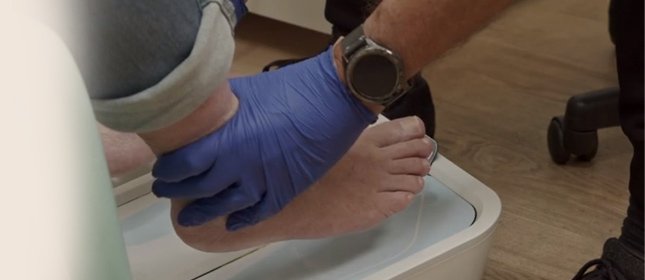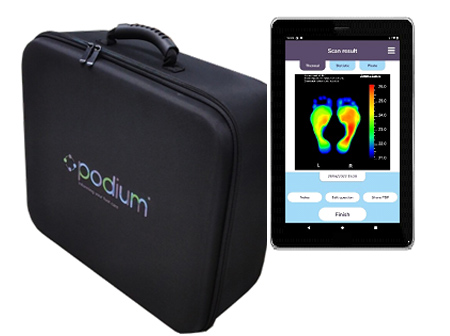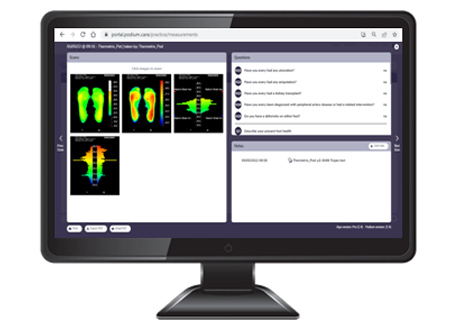
Ⓒ 2020- by Thermetrix Ltd.
For Clinicians |

|
|
|

Podium is a foot thermal imaging device, providing a high-resolution temperature map of patients’ feet. Podium comes with three foot plates to obtain the optimal thermal profile for different foot temperatures. Fully cleanable, class 1 medical device.
The Podium system features a dedicated control tablet to guide the scan process and provides instant and historical viewing of results. Reports can be printed or shared straight from the control tablet. Fully portable.


Patient scans are automatically stored on a cloud-based portal, for historical retrieval and analysis. Our base hardware and software support package includes access to our shared server. We also provide privately managed servers as required by our customers Our portals run in any modern browser, no software to install, come with automated backups and are fully GDPR compliant.
“Using the Podium Professional in the clinic has meant that some of our patients have successfully avoided their condition developing to surgical intervention! Scanning feet really does save lives.”
“Podium hones your attention and skill into an area that may not be so obvious to the naked eye.”
“Podium helps you see their pain”
“This is a no-brainer!”
A pilot study in Bermuda used Podium Professional to assess foot health through
temperature imagery has helped more people avoid surgery.
Bermuda has alarmingly high rates of Diabetes (13%) compared with the UK (6%).
The device was trialled at two clinical sites on existing patients either as part of their regular checkups or when seeing
clinicians due to an urgent condition. The initial pilot study was part of Bermuda Health Council’s ‘Innovation Program –
Digital Health Solutions’.
After the first phase of the study, Dr Neil Moncrieff from the Bermuda Podiatry Centre said: “Using the Podium Professional
in the clinic has meant that some of our patients have successfully avoided their condition developing to surgical intervention.
Scanning feet really does save lives.”
For patients being admitted to the Diabetes Centre in Bad Lauterberg, Germany, part of the initial patient assessment now includes thermographic foot scanning using the Podium system. Dr. Thomas Werner is the lead clinician at the centre and introduced Podium thermographic foot imagery to their standard protocols. Dr. Werner has commented that it is often the lack of active temperature control which is important to assess alongside characteristic features such as asymmetry, temperature gradients, hot spots and cold areas, which are much more robust indicators than absolute temperature measurements.
Read MorePodium showed potential infection present due to ankle wound. The patient is an elderly male suffering from diabetes for over 20 years, and the test showed feet are neuropathic. Podium scan results showed a large asymmetrical temperature difference in the patient’s heels, which confirmed inflammation and or infection was present due to an ankle wound. With the additional evidence from Podium, the Clinician made the decision to act fast to manage any potential infection, together with prescribing orthotics and increasing patient visits and follow-up Podium scans.
ReportPodium is used as an educational tool to help improve compliance. The patient is an elderly male who has been suffering from diabetes for 24 years. The patient has neuropathy in the right foot and feels no pain, making him a high risk of developing a diabetic foot ulcer. Podium scan results showed that the functional foot orthotic and shoe advice previously given were working as the degree of inflammation had lowered. The informative scan results were shown to the patient to ensure continual compliance given the lack of pain and high-risk stratification.
ReportPodium helped prevent a foot ulcer from occurring. The patient is an elderly male with diabetes and neuropathy. Whilst not visible to the naked eye, the 'hot spot' was detected on the patient's 5th metatarsal on their left foot. Given the size of the asymmetrical temperature difference, the clinician was able to categorise the area as an early diabetic foot ulcer. The Clinician provided advice on footwear and prescribed protective padding around the inflamed area, together with increasing the frequency of visits.
ReportPodium scan results facilitated immediate orthotic prescription, preventing the need for referral to a GP. The patient presented with a swollen foot for 8 days. After a Podium scan identified a large asymmetrical temperature difference of 3℃, the Clinician prescribed orthotics to support foot function and limit any possible joint damage. A follow-up scan 2 weeks later confirmed the orthotics had worked show a much smaller temperature difference of 1℃.
ReportPodium provided additional evidence to help expedite a referral for the patient. The patient is an elderly female suffering from Polymyalgia Rheumatica. The patient was experiencing greater than normal pain. Podium identified a small asymmetrical temperature difference of the metatarsophalangeal joints in the patient’s feet. This was enough to fast-track the patient through to an X-ray which confirmed a fractured metatarsal.
ReportThermal imaging of the plantar foot can visualise many conditions affecting the Diabetic Foot such as neuropathy, micro- and macroangiopathy and potential the emergence of an ulcer. Written in collaboration with 4 internationally recognised diabetic foot and thermography experts the white paper summarises the key features of Thermographic Diabetic Foot Assessment in Podiatric Practice.
White PaperA brief summary poster, showing why thermal foot assessment is such a powerful clinical tool, highlighting the 4 key approaches where a deviation from the normal skin temperature pattern indicates potential pathological processes.
PosterA brief PDF guide on how to use Podium in the assessment of feet and how to interpret foot scans. Contains 3 case studies as examples.
PDF GuideA fully annotated Powerpoint™ slide presentation on how temperature Assessment of the foot can inform patient care.
PPT SlidesThe paper outlines the development and validation of a clinical prediction rule for foot ulceration in people living with diabetes. 8,255 cases were used for the development of the risk assessment tool and 3,324 cases were used to validate it. This resulted in a 5 point scoring system that predicts the risk of developing a foot ulcer with good accuracy.
Read MoreThis meta study systematically reviewed of 10 research papers with the aim of ascertaining the healing percentage of neuropathic diabetic foot ulcers when receiving standard quality wound care within a specified time frame. The results revealed that after 12 weeks only around 24% of ulcers healed and after 20 weeks still only 31% ulcers heal. These long healing times demonstrate the urgent need to prevent ulcer formation in the first place.
Read MoreThis research studied amputation-free survival rates among individuals with diabetes at high risk for foot ulceration, categorising them based on their ulceration status: no previous ulcer, active ulcer, or healed previous ulcer. The study found that individuals with healed ulcers had higher death rates, but those with active ulcers had the highest risk of amputation, emphasising the critical need for early intervention and management in high-risk individuals.
Read MoreThis prospective study explored outcomes such as mortality, rehabilitation, and recurrence of amputations in diabetic patients post-healing of an initial amputation, categorising them based on the extent of the initial amputation. The results showed a significant difference in mortality rates and rehabilitation potential between minor and major amputations, with major amputations showing higher mortality and lower rehabilitation potential. Notably, 85% of new amputations were precipitated by a foot ulcer, emphasising the importance of meticulous foot care and monitoring in diabetic patients.
Read MoreThis paper inspired the use of combined thermal and visible light imaging in Podium. It concludes that the diagnosis of foot infection in patients living with diabetes seems valid and reliable when using photographic imaging in combination with infrared thermography in at-home monitoring of high-risk patients to facilitate early diagnosis of signs of foot infection.
Read MoreThis research aimed to quantify the healthcare costs associated with diabetic foot disease in England, focusing on the financial burden of foot ulceration and amputation. The study revealed that the healthcare costs related to diabetic foot disease are substantial, estimated between £837 million and £962 million annually, constituting a significant proportion of the National Health Service (NHS) budget for England. The majority of this expenditure is attributed to ulceration, with potential substantial savings if the prevalence of diabetic foot ulcers is reduced, emphasising the critical need for effective prevention and management strategies. Infrared thermography in at-home monitoring of high-risk patients to facilitate early diagnosis of signs of foot infection.
Read MoreThis study analysed diabetic foot ulcer (DFU) management within the UK's NHS, revealing predominant community management with minimal specialist involvement. It uncovered inefficient care, with only 35% of DFUs healing within 12 months and 17% undergoing amputation within the first 12 months. The mean NHS cost per DFU over 12 months was £7,800. The study highlighted the potential benefits of strategies focusing on wound prevention, improved wound-healing, and reduced infection and amputation rates for both patients and the NHS.
Read MoreFor private podiatrists looking to integrate Podium into their practice: Contact Us
For NHS podiatrists, Podium Professional is available on the NHS supply chain (NPC code: ERP6362).
.

Ⓒ 2020- by Thermetrix Ltd.